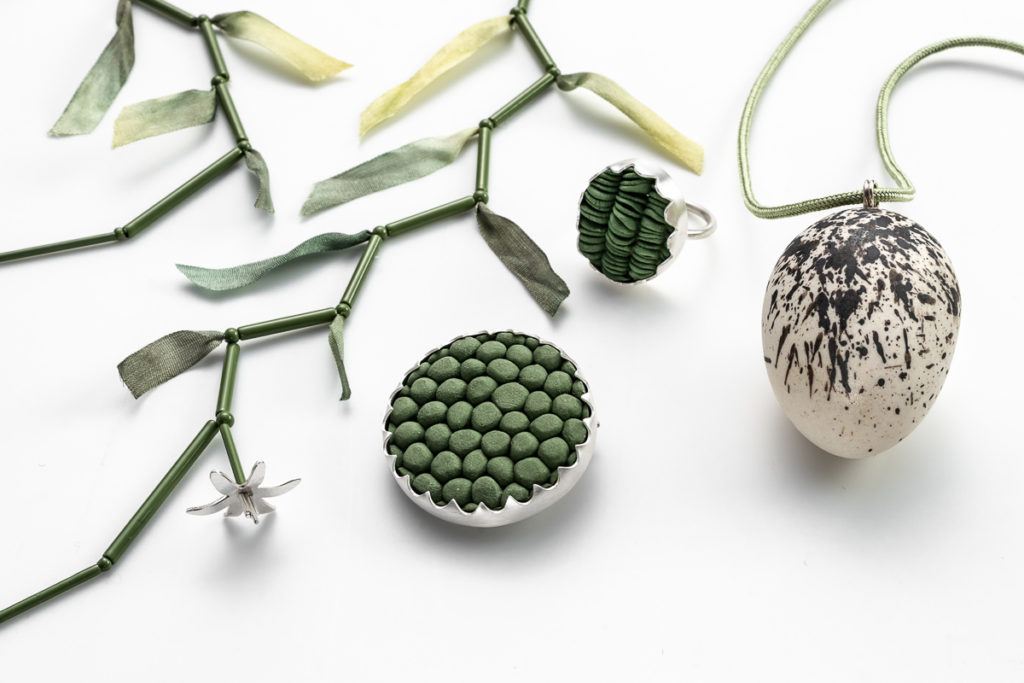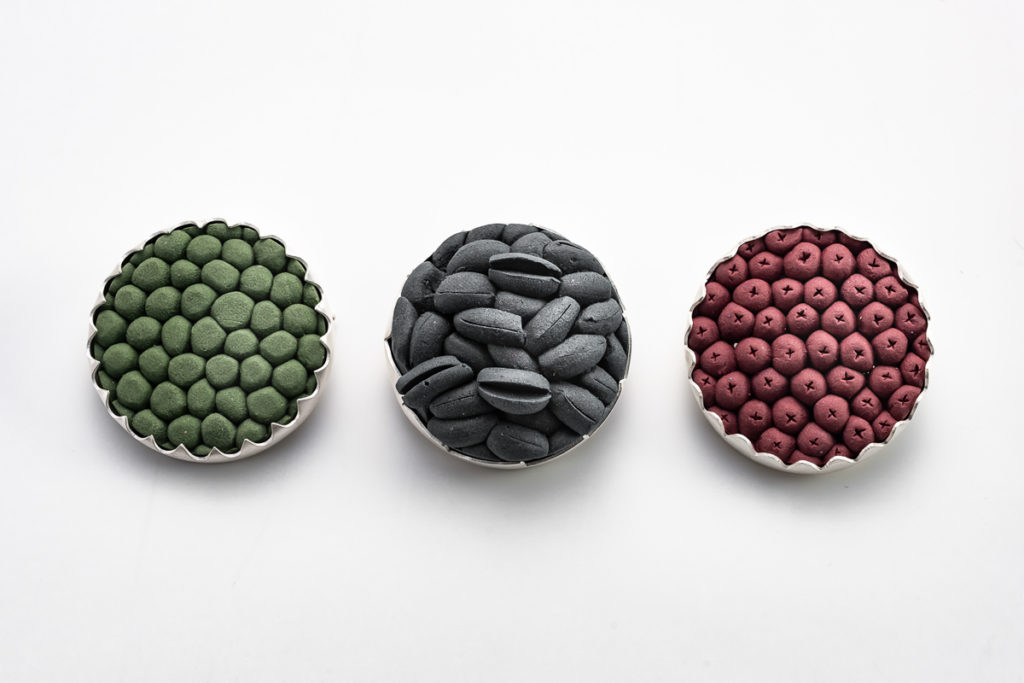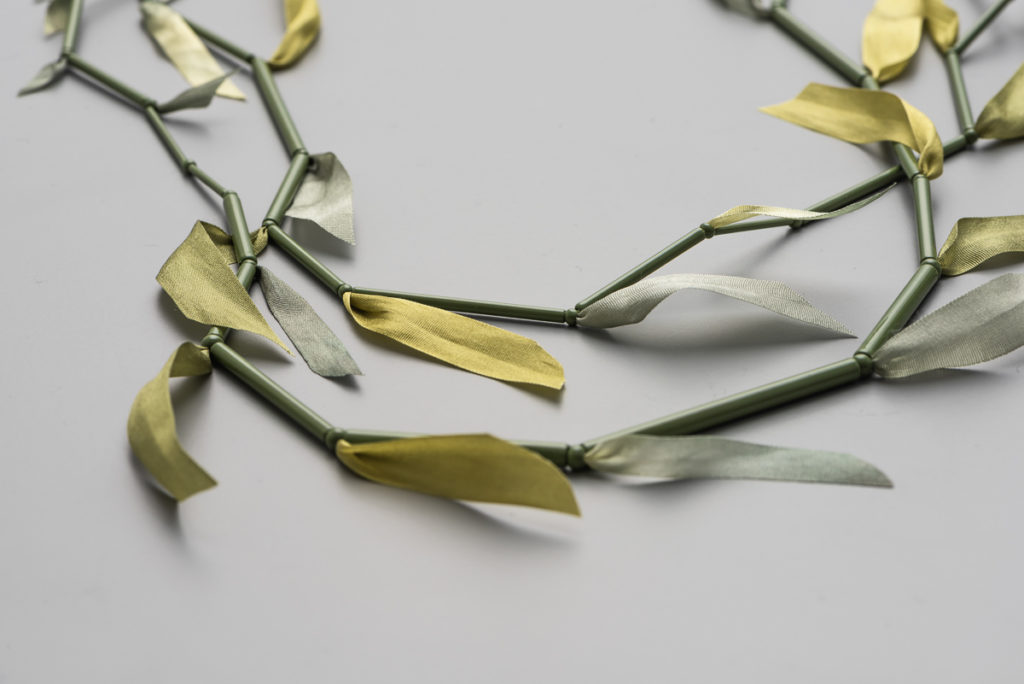Helen Wyatt describes some of the learnings revealed in the stunning new jewellery series by Alice Whish whose work was inspired by her Bundanon residency.
Alice Whish has a new body of work created as a result of a 2018 residency with Vicki Mason at the Arthur Boyd Property, Bundanon, on NSW’s south coast. Together, they have held a show at Craft Victoria in Melbourne that coincided with the contemporary jewellery biennial, Radiant Pavilion 19.
Alice Whish has created delicate wearable objects – sensuous in their tactility and intriguing in their attention to detail. In the exhibition both Alice’s work and that of Vicki Mason were physically interwoven in some sections; in others, they were grouped separately.
Alice’s work, comprising rings, brooches, necklaces and earrings, reference the plants and birds of the understory within a very small area of the forest at Bundanon. In creating the works, she was particularly interested in the cultural burning practices—cool burning—of the Mudjingaalburaga fire group.
When she arrived burning had recently been undertaken and another burning event occurred while Alice was there. This experience allowed for some deep learning about the diversity and growth of the forest.
What she was able to witness was the leaf regrowth of banksias, grasses and vines after a burn and how invasive species would be easily burnt, but not the native ones. She also observed that the burn occurred around the bottom of the trees but did not rise up, unless the tree was hollow.
Her research led her to hear stories from the Dharawal speakers and those of the Yuin nation. The lyrebird, for example, is linked to fire through an ancestral story Wiritjirbin and respected by Dharawal speakers (Matthew Doyle, podcast, Radio Eye, 1997) It is also an important agent in the ecology of the forest soil, turning over 150 tons of soil per hectare in a year. This practice of burying the leaf litter is in itself a natural retardant to fire. (Alex Maisey ABC podcast 2019).
Consequently, she has featured the grasses, seeds, smoke and lyrebird eggs in her work. With each of these elements though, she has been drawn to their technical forms. She has delved into this nature and found mathematical structures: how the grasses are joined and how the seeds line up in a pod.
It is this mathematical enquiry and an interest in geometry—particularly the circle and the star—that have appeared in works throughout Alice’s practise over the years.
Whish has been innovative in the use of materials. In this case she has combined silver with porcelain and silk. She has taken a malleable/fluid material—clay—and applied her metal skills (pressing, rolling, embossing, casting) to it. She relishes the hand-built quality but equally enjoys its 3D printed look.
I asked her about the referential nature of her work and she responded by seeing the literalness of some of the forms she has created as an opportunity to share her new insights. These insights don’t jump out to the observer without the mediation of the artist’s careful eye. The porcelain eggs are explicitly represented. She noted that so few of us are ever going to see a lyrebird egg. Even museums only have a handful as they are quite hard to find. Less literal are the seeds that are more interpretive and simplified.
Vicki Mason’s focus was on the canopy as well as how knowledge about plants is diminishing. The work of both artists is complimentary. They are unified by the directness and simplicity of the forms together with the artists’ mutual interest in this special place.
Alice’s current body of work links back to the time when she first looked at plants deeply. She was studying the botanical references and descriptions of Pyrmont found in the MacArthur family letters describing their picnics in this place.
As with that project, her current one is a way of explaining the value of plants. The preciousness of the understory displayed on walls is an aesthetic and educative experience or the objects can be worn as beautiful pieces that also invite conversation. The Aboriginal people of the area know the inherent value of the nature found at Bundanon and the practices they have applied for millenia to nourish its sustainability.
She has yet to show her exhibition to the local Aboriginal community— The Mudjingaalburaga in particular. She notes though, that they are used to seeing artists respond to the blackness in the burnt landscape and yet it is the colour of renewal that is the real hope and value of the burning. It is a colour that Alice and Vicki have foregrounded in their work.
With Alice Whish’s research, it is easy to see her resonance with Fiona Hall’s botanical pieces, Paradisus Terrestris, from 1989-90. Hall’s work at that time drew on carefully researched plants, which were investigated for their scientific, symbolic and aesthetic qualities.
Similarly, there is the respect for the knowledge of Aboriginal people about land and their integration of knowledge with art. She cites Aboriginal artists Mavis Ganambarr and Rose Mamuniny from Galiwin’ku (Elcho Island) as collaborators and teachers. From them, she learnt how to make work using historical processes and ephemeral materials. She is mindful to not appropriate their practices but to think of her own work with a fresh eye.
Both Alice Whish and Vicki Mason are part of a tradition of Australian artists (Aboriginal and non-Aboriginal) who have been fascinated with the botanica of the Australian bush. Both artists in Bundanon have helped us look and think about plants in new ways. In particular, Alice Whish has taken us to a place beyond voluptuous flowers and exotic animals to see the intimate and peculiarly Australian regeneration of the forest through fire.
These works were on exhibition in the JMGA Profile show at ADC William St Sydney in November 2019, and in 2020 Alice and Vicki will exhibit at Stanley Street Gallery. Some of Alice’s work is also available for purchase through the shop at Craft Victoria.
Author
 Helen Wyatt is a visual artist and arts writer and has recently completed her Masters of Visual Arts (Research) at Queensland College of Arts, Griffith University in Jewellery and Small Objects. Her work plays with the fragments and traces found in places where industry and nature intersect suggesting stories or re-imaginings.
Helen Wyatt is a visual artist and arts writer and has recently completed her Masters of Visual Arts (Research) at Queensland College of Arts, Griffith University in Jewellery and Small Objects. Her work plays with the fragments and traces found in places where industry and nature intersect suggesting stories or re-imaginings.





